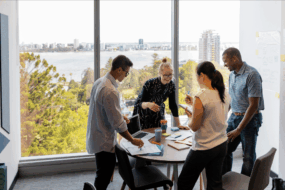
Videos are now a marketing crowd pleaser. In our world of pervasive smartphone use, near-ubiquitous internet access, and the stratospheric popularity of social media and content sharing platforms, interactive visual content has emerged as one of the preferred means of information consumption.
According to recent statistics, roughly 85% of all internet users in the US consume video content on their various devices at least monthly. More importantly, 55% of US consumers, in that same poll, said that they would like to see more video content from brands they follow and support.
Video might not completely displace conventional content marketing (i.e. articles and blog posts), but more people are clamoring for engaging videos alongside textual information.
Video Content and Ecommerce Marketing
You might ask, is video content a rewarding area to devote my effort, time, and money as an ecommerce marketer? It’s a fair question. Branded videos can be time-consuming and require a monetary investment. However, when done well, this strategy can be highly rewarding.
These days, video content is proving itself instrumental in many successful ecommerce marketing campaigns. Since a whopping 55% of internet buyers consider product videos when making an online shopping decision, using videos can boost your website’s conversion rate immensely.
Here are a few advantages that videos can have on your brand marketing:
- Product reviews help create a lasting image of your products in the minds of your audience.
- Video versions of product descriptions alongside high-quality photos attract viewers by highlighting product features that might appeal to them.
- Ads on platforms like Youtube and Instagram can draw in more brand loyalists, get the word out faster, and widen your conversion funnel.
- Videos have been proven as the best form of content for social media.
These are all great reasons to use video content in your ecommerce marketing, and they are just the tip of the iceberg. As we will see in the coming paragraphs, video content is the future, and you’ll have to pay attention to video trends in order to future-proof your ecommerce business.
While you might already be used to the more common ways to implement video content, this article will consider a few of the roads less traveled in video content marketing. We’ll first take a quick look at some of the forms of web video content, and then we’ll discuss how and when you should use these content types.
Categories of Video Content
While they may share certain traits and features, not all videos are created equal. As we explore the different web video content categories that are relevant to ecommerce, you’ll find that different kinds of videos are required for certain scenarios.
Product Overview
Different from a video review, this particular type of video goes into detail in describing a product. It analyses the product’s features, strengths, use cases, and unique benefits. Conventionally, this type of video usually shows a speaker or host demonstrating how the product works and explaining to consumers why they should consider buying it.
Videos like this can even be used before a product is officially launched. They can help create buzz around a product in the days, weeks, and months leading up to its eventual release and availability, attracting pre-orders and advance sales.
Tutorials
Tutorials have emerged as one of the most value-packed mediums of video content marketing. Here, the speaker hones in on the product’s chief features and demonstrates how buyers can take advantage of these features for themselves. Using linear, step-by-step instructions, the video shows customers how they can take full advantage of the product’s full range of benefits.

Apple (pictured above) is notorious for taking full advantage of tutorial videos. Ahead of a major new iPhone launch, the company releases tutorial videos that focus on the new model’s headliner feature. For example, with 2017’s iPhone X, the company showed off its new FaceID sensor and explained how it could be used by customers. When customers feel confident they will be able to use a product correctly and get the most out of it, they are more inclined to buy.
Founder/CEO Message
This type of video content is specific to certain situations and can be difficult to get right, but ecommerce businesses have frequently turned to this medium as a powerful tool with which to add credibility to their respective brands and, by extension, their products.

A well-timed, well-delivered message from a senior person in your company, such as the CEO, Founder, or Owner, can help customers feel more connected to your brand.
OnePlus is a company that frequently leverages the power of founder messages. Its CEO, Carl Pei, gets on camera frequently to thank customers for their continued loyalty to the business and explain a clear plan that the company has for the future.
Customer Journeys
Alternatively known as explainer videos, these are usually short (30 seconds to one minute is typical) and paint a succinct picture in the minds of the viewers. Deviating from the features of a product, these videos are designed to tell an emotional story about how a customer, on finding your product, was able to achieve the desired results and solve a real problem in their lives.
How to Use These Videos in Your Content
Now we get to the real nitty-gritty. Since we’ve taken a broad look at some of the kinds of video content that are available to you as an ecommerce marketer, let’s go over some of the unique ways you can add value to your customers’ experience by implementing video content into your marketing strategy.
Tell an Emotive Story
Leveraging the customer journey, you can arouse the emotions of your viewers with excellent storytelling and filmmaking. This can help imprint your store’s identity deep in the minds of your potential buyers. Remember to focus on benefits, not features – the point is not how great your product is, but how it helped your customers.
These stories can also hark onto existing movements and trends. For example, young women are more likely to develop a positive impression of a brand whose message is perceived as empowering. Viewers are also keener to interact with, comment on, and share these videos.
You can post these videos on the product’s ecommerce page or on your social media platforms.
Place Product Features Front and Center
If you’re trying to sell a product that is purpose-built to fill urgent consumer needs, tutorials on the product description page are the way to go. By showing customers the value of a product, you’d be going a long way in swaying their buying decision and convincing them to either invest in that product category for the first time or switch over to your own iteration of the product.
For example, if you’re trying to sell a portable razor, a well-made tutorial showing users how easy it is to set up, use, and clean would be of immense value to users.
Videos are a godsend for effective tutorials since it’s difficult to take customers through a complex product’s features using text and static images alone.
Weave Videos Into Your Email Marketing Strategy
Video content isn’t just for your website and social media. Videos are perfect for things like email reminders, newsletters, cart abandonment emails, and general remarketing campaigns. For example, you might include videos in your regular email newsletters to capture the reader’s attention and improve email open and click-through rates. What’s more, popular ecommerce solutions like Shopify and alternative platforms also allow for full email support and integration.
Some go-to tips for email video content include:
- Make sure to use the word “video” in the email subject line
- Place your video below a short snippet of copy introducing it in the email
- Enable autoplay, but set the sound default to “off”
- Implement fun animated thumbnails
- Describe the video with a caption, clearly spelling out the benefits customers will get from watching it
- Ensure your newsletter design is responsive, enabling customers to view the video on either mobile or desktop devices

Email reminders also benefit from video content. For example, imagine you’re trying to draw the attention of a visitor to a coupon code that is about to expire. You can use a short video showing them how to use the coupons on the checkout page of your ecommerce website. This value-add will spur them to click the link, complete their purchase, and use their discount before it expires.
When you’re designing thumbnail or header images for emails, make sure that they’re crisp, convincing, and relevant to the content of the video.
Animated Product Overviews are a Fun Way to Engage Buyers
Animated videos provide a lighthearted, entertaining way for customers to learn about your product. By offering a piece of content that is more casual but also informative and valuable, consumers are more likely to let their guard down and see what your product is all about. If you can make them smile or induce an emotional response, you’re halfway there.

The screenshot above was taken from one of Crazy Egg’s most popular animated product description videos. Using colorful graphics and whimsical avatars, the video shows potential users how the company’s website management and optimization tool helps them achieve their sales goals.
Animated videos enjoy a high degree of shareability. These can go viral pretty fast if they’re of high quality. What better reason is there to look into posting animated product overview videos on your ecommerce website’s social media accounts?
Well-Crafted Testimonials are a Crowd Pleaser
More than ever before, buyers viewing products on ecommerce sites go in with doubt and apprehension. One of the best ways to disarm that doubt is by using testimonials. Importantly, these testimonials don’t have to always refer to a particular product (though they can). You can create testimonials that reference past customers’ experience with your website in relation to their shopping experience.

In the example above, Verrier Boutique pulled the testimonial from its website and used it as an accompanying piece of text for a Facebook post.
If you’re making a product-specific testimonial, be sure to capture the most important bits of information from the satisfied buyer: the product’s chief features and how it was able to solve their problem. Testimonials are highly engaging and can drive huge sales for your store.
Conclusion
Ecommerce marketing is a step-by-step process that requires a consistent and conscientious effort to drive results. The competition has never been fiercer. While you might be focused on a few preferred marketing channels, videos are an important facet of today’s brand marketing space and can serve as rocket fuel for ecommerce sales. In other words, smart marketers know that video content shouldn’t be overlooked.
Endeavor to implement at least some of the aforementioned video content tips so that you can hit optimum return on investment and draw in more recurring customers.
Remember, just as you would with any other marketing element, you can also measure the success of the different cogs in your video content marketing wheel. Here’s to the success of your sales and marketing efforts this year!
Jimmy Rodriguez is the COO and co-founder of 3dcart, an ecommerce software to build SEO-friendly online stores. He’s dedicated to helping internet retailers succeed online by developing digital marketing strategies and optimized shopping experiences that drive conversions and improve business performance.





